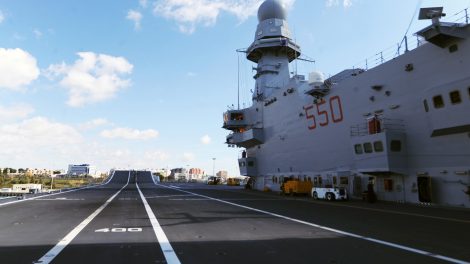The text, originally titled “The EU needs clear guidelines to improve interoperability while avoiding fragmentation in order to cope with growing global competition in the Defence industry,” was written for the Opening speech at the roundtable “From the Ashes: Innovation and Evolution of the European Defense Industrial Base” organised within the Prague European Summit 2021. It was lightly edited for the sake of readability.
As Operation Commander of a very important [Common Security and Defence Policy] Operation, I will offer some considerations on the European defence industrial base and on what an operation such as EUNAVFOR MED IRINI needs to fulfil its tasks.
With the launch of Operation IRINI, the EU has demonstrated its ambition to act as an important security provider. This ambition confronts Member States with the dual need for greater cooperation in defining strategic objectives, and better financial planning for resources to be allocated to capacity building.
In the European Defence industry, national interests still play a key role. You might have heard of some impressive figures: today, the EU’s 27 spend about €230 billion for 180 different weapons systems, compared to 30 in the United States. Interoperability and avoiding duplications are critical issues, not just the issue of reaching 2% of GDP.
In 2020, the US continued to be the largest military spender with a budget of $778 billion (about 3,7% of GDP), followed by China with $252 billion (about 1,9 % of GDP). Compared in terms of real purchasing power, Chinese spending amounts to approximately 2/3 of US spending.
While the US and China are the largest military spenders and leaders on AI and cyber, the EU’s defence industry and Member States fail to cooperate with European start-ups – as highlighted by Nicholas Nelson in the Micro-Study that was prepared for this Summit. The bottom line is that technological supremacy also means geopolitical and military advantages and that Europe can no longer remain inactive.
Anyhow, I am not pessimistic because there are several promising European initiatives. The EU is currently developing the Strategic Compass from which the new European Level of Ambition will be derived. One of the four domains is the “development of capabilities.” Here, the main focus must be overcoming fragmentation.
Recently, the Commission released the “Action Plan on Synergies between Civil, Defense and Space Industries“ to further enhance Europe’s technological edge and support its industrial base.
The goal of the action plan is to link the three dimensions and achieve technological sovereignty.
Within the action plan’s 11 concrete points, two are of vital importance from the point of view of Operation EUNAVFORMED IRINI.
First, the development of “flagship” projects, particularly drones, and thus the additional ability to integrate military know-how into civilian drone technology.
I need not explain the importance of being able to employ a UAV/drone in our Operation. Unmanned Arial Vehicles put no humans at risk, are relatively cheap and can be operated for a long time without the need for frequent breaks.
This will not come as a surprise: drones provided to Irini by Member States are not made in Europe, but in the US and Israel. In the future, we definitely need more – and in particular, qualitatively more advanced – European UAVs.
The second item of vital importance for Operation IRINI is satellite connectivity. Space asset management is a key component to enhance the EU’s military capability. Without satellites, IRINI would not be capable of following through on its tasks. We use the EU Satellite Centre’s services, which provide valuable imagery analysis and imagery intelligence, on an almost daily basis. SATCEN is a great example of what the EU can achieve if it jointly uses the Member States’ most modern assets and technologies. In addition to satellite imagery, satellite connectivity is already essential for the Operation’s communication networks, and this will only become more important in the future.
Progress in European initiatives can also be observed when it comes to financing projects. Among the various instruments is the European Defence Fund (EDF). It supports multinational activities in the field of defence industry research and military capabilities. The EDF lays the foundations for the EU defence industry to develop modern know-how and interoperable capabilities.
The aforementioned initiatives will allow – in the medium to long term – to increase cooperation between Member States and allies, and will strengthen the European defence industrial base in the global race for technological sovereignty.
In conclusion, global competition in the defence industry is increasing. In this very particular market, national interests still play a key role. Therefore, the EU needs clear “political-military guidelines” to enhance interoperability among Member States while avoiding fragmentation.
With the European Defence Fund and other initiatives, the EU finally has new financing schemes to support the joint development of modern assets for the armed forces and EU operations such as IRINI.
Approaching innovation alone and without intense cooperation will not help us compete in the global market, and particularly with those non-Western players that threaten to increasingly jeopardize our security in the very near future.




